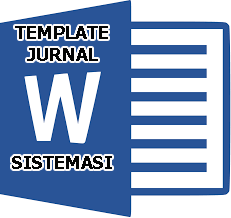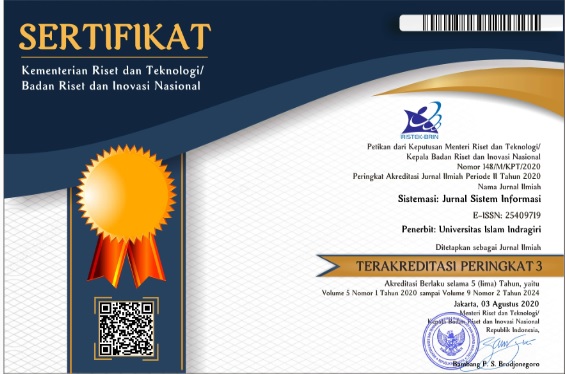Social Media Adoption in the Marketing Strategy of Radiant Buket SME: A UTAUT Model Approach
Abstract
Keywords
Full Text:
PDFReferences
D. Y. Prasetyo, F. Yunita, A. Bindas, S. Samsudin, and A. Muni, “Social Media Marketing di Masa Pandemi,” Community Dev. J. J. Pengabdi. Masy., Vol. 2, No. 3, pp. 979–988, 2021, doi: 10.31004/cdj.v2i3.2828.
R. Stockdale, A. Ahmed, and H. Scheepers, “Identifying Business Value from the use of Social Media: An SME Perspective,”in Proceeding of the Pacific Asia Conference on Information System (PACIS), Ho Chi Minh City, Vietnam, 2012.
M. Nurpratama and S. Anwar, “Penerapan Digital Marketing bagi Usaha Mikro, Kecil dan Menengah (UMKM) di Kelurahan Karangmalang Kecamatan Indramayu Kabupaten Indramayu,” J. Investasi, Vol. 6, No. 2, pp. 87–102, 2020, doi: https://doi.org/10.31943/investasi.v6i2.83
Cholidatul Lifia, Ainur Rochmaniah, and Poppy Febriana, “Pemanfaatan Digital Marketing dan Branding Media Sosial dalam meningkatkan Daya Saing UMKM MRS Snackket,” J. Abdimas Ilm. Citra Bakti, Vol. 5, No. 2, pp. 521–534, 2024, doi: 10.38048/jailcb.v5i2.3537.
Cholifah, R. Dijaya, A. S. Gracia, and U. K. Nisak, “Factors Influencing The Implementation of Electronic Medical Records (Remics) Based on Unified Theory of Acceptance and Use of Technology (UTAUT) in Sidoarjo Hospital,” Procedia Soc. Sci. Humanit., Vol. 1, No. c, pp. 860–866, 2022, doi: https://doi.org/10.21070/pssh.v3i.264
W. Puriwat and S. Tripopsakul, “Explaining Social Media Adoption for a Business Purpose: an Application of the UTAUT Model,” Sustain., Vol. 13, No. 4, pp. 1–13, 2021, doi: 10.3390/su13042082.
J. Erjavec and A. Manfreda, “Online Shopping Adoption During COVID-19 and Social Isolation: Extending the UTAUT Model with Herd Behavior,” J. Retail. Consum. Serv., Vol. 65, No. November 2021, p. 102867, 2022, doi: 10.1016/j.jretconser.2021.102867.
G. Esmemed, G. Testiana, and F. Nopriani, “Analisis Kepuasan Pengguna terhadap Penggunaan Aplikasi Transportasi Online dengan Metode Unified Theory Of Acceptance And Use Of Technology,” J. Comput. Inf. Syst. Ampera, Vol. 2, No. 2, pp. 78–93, 2021, doi: 10.51519/journalcisa.v2i2.62.
A. Fitra and D. Kurniadi, “Analisis Kepuasan Pengguna Aplikasi Automatic Meter Reading (AMR) menggunakan Metode UTAUT,” INCARE, Int. J. Educ. Resour., Vol. 1, No. 4, pp. 335–349, 2020.
H. Sudarsono, L. lak N. El Hasanah, J. S. A. Shidiqie, and I. Supriani, “Antecedents of Muslim Students’ Adoption of Mobile Banking: An Extended TAM and UTAUT Approach,” J. Organ. dan Manaj., Vol. 20, No. 1, pp. 114–128, 2024, doi: 10.33830/jom.v20i1.7514.2024.
A. Purwanto, M. Asbari, and T. I. Santoso, “Analisis Data Penelitian Marketing: Perbandingan Hasil,” J. Ind. Eng. Manag. Res., Vol. 2, No. 4, pp. 216–227, 2021, [Online]. Available: https://ijospl.org/index.php/ijospl/article/view/64
I. M. A. A. Pering, “Kajian Analisis Jalur dengan Structural Equation Modeling (SEM) SMART-PLS 3.0,” J. Satyagraha, Vol. 03, No. 02, pp. 28–48, 2021, doi:10.47532/jis.v3i2.177
L. Rahmawati, I. Mariam, and T. Purwinarti, “Analisis Perkembangan UMKM dan Kuantitas Belanja Daring pada Masa Pandemi dengan Model UTAUT 2,” in *Seminar Nasional Riset Terapan*, Vol. 10, No. 1, pp. 19–30, 2022.
A. A. Onibala, Y. Rindengan, and A. S. Lumenta, “Analisis Penerapan Model UTAUT2 terhadap E-Kinerja pada Pemerintah Provinsi Sulawesi utara,” E-journal Tek. Inform., Vol. 2, pp. 1–13, 2021, [Online]. Available: http://repo.unsrat.ac.id/2974/
A. Ayaz and M. Yanartaş, “An Analysis on the Unified Theory of Acceptance and Use of Technology Theory (UTAUT): Acceptance of Electronic Document Management System (EDMS),” Comput. Hum. Behav. Reports, Vol. 2, No. September, 2020, doi: 10.1016/j.chbr.2020.100032.
I. H. Aljabbaru and D. Sari, “Analisis Penggunaan Mobile Payment Linkaja dengan menggunakan Model Unified of Acceptance and use of Technology (UTAUT),” e-Proceeding Manag., Vol. 7, No. 1, pp. 1151–1163, 2020.
F. Bayhaqi and I. K. D. Nuryana, “Analisis Kepuasan Pengguna Layanan Aplikasi Bima+ dengan Metode UTAUT,” Jeisbi, Vol. 3, No. 03, pp. 84–93, 2022, [Online]. Available: https://ejournal.unesa.ac.id/index.php/JEISBI/article/view/47087/39404
J. F. Andry, Herlina, and A. Rianto, “AnaIisis Kepuasan Pelanggan pada E-Commerce Shopee dengan Metode UTAUT Customer Satisfaction Analysis on Shopee E-Commerce using the UTAUT Method,” Cogito Smart J. |, Vol. 9, No. 1, pp. 73–83, 2023. doi: 10.31154/cogito.v9i1.454.73-83
P. N. Auliya and M. F. Arransyah, “Penerapan Model UTAUT untuk mengetahui Minat Perilaku Konsumen dalam Penggunaan QRIS,” Ekon. Keuangan, Investasi dan Syariah, Vol. 4, No. 3, pp. 885–892, 2023, doi: 10.47065/ekuitas.v4i3.2808.
R. H. Dai, R. Raupu, and I. R. Padiku, “Penerapan Metode UTAUT dalam menganalisis Tingkat Kepuasan Pengguna Sistem Informasi Kearsipan Dinamis Terintegrasi (Srikandi),” Digit. Transform. Technol., Vol. 4, No. 1, pp. 87–96, 2024, doi: 10.47709/digitech.v4i1.3476.
R. Apriyani and D. Pibriana, “Penerapan Model UTAUT untuk menganalisis Penerimaan dan Penggunaan Sistem Informasi E-Office (Studi Kasus: PT ABCX) Application of the UTAUT Model to Analyze Acceptance and use of E-Office Information Systems (Case Study: PT ABCX),” J. Tek. Inform. dan Sist. Inf., Vol. 8, No. 3, pp. 1557–1569, 2021, [Online]. Available: http://jurnal.mdp.ac.id
DOI: https://doi.org/10.32520/stmsi.v14i4.5330
Article Metrics
Abstract view : 405 timesPDF - 105 times
Refbacks
- There are currently no refbacks.

This work is licensed under a Creative Commons Attribution-ShareAlike 4.0 International License.









